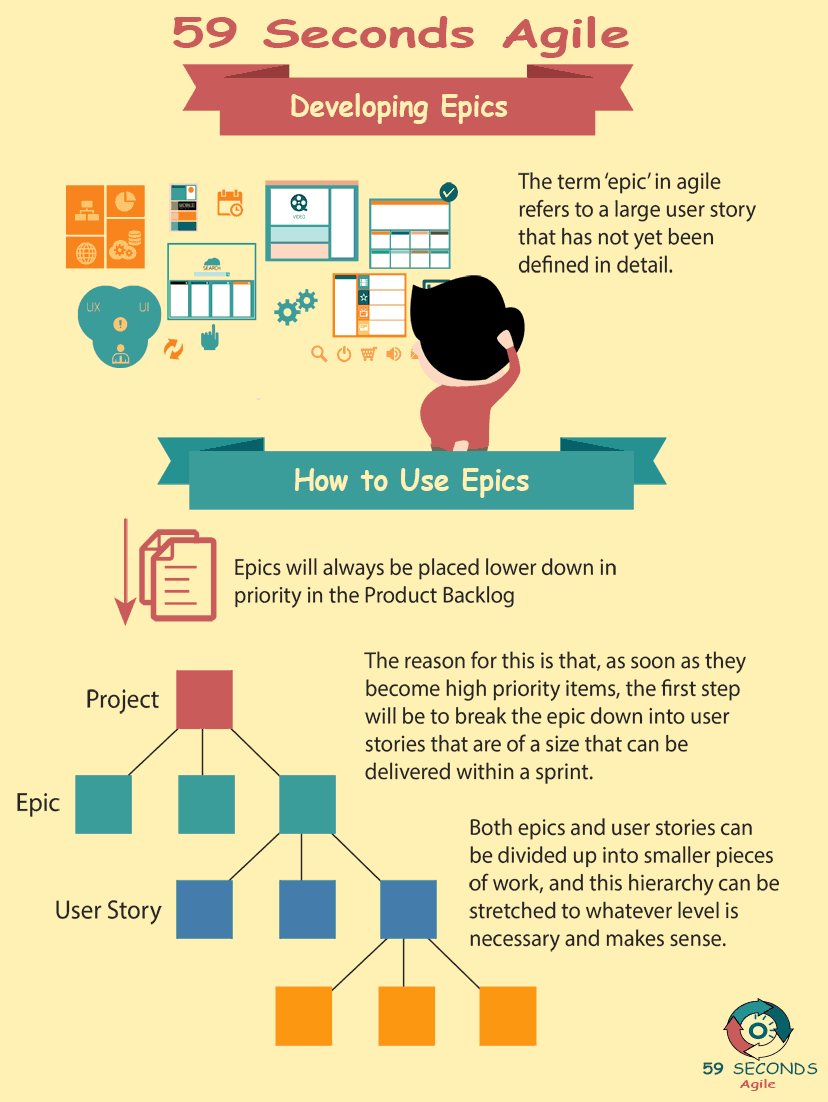What are Scrum Epics and who is involved in Developing Scrum Epics? and who is responsible for creating them? The Development of Scrum Epics is an important part of the planning process within an Agile project.
Developing Scrum Epics
A 59 Seconds Agile Video Animation
Developing Epics for Developers
A 59 Seconds Agile Article
Developing Scrum Epics for Developers – Part 2
Developers in Collecting Scrum Epics
User stories and epics can come from a variety of sources. The collection method depends on what works best for both the Scrum team and the stakeholders. Some of the more common tactics include interviews, user group meetings, questionnaires, observations, and user story workshops. For developers, the best methods are ones that can be qualified and digitized. Documentation that the developers can read back over is convenient. The feedback that can be put on a scale or divided into categories can be analyzed on a meta level.
Methods like observations and user group meetings are more convenient for stakeholders. They simply do what they normally do, and the Scrum team pulls data from the results. The problem for developers is that the data is less quantifiable. Without concrete information, developers are less able to plan for epics. With enough research, observation and group meetings can work, but they are less developer friendly.
Scrum Epics Workshops
User story workshops and interviews are a middle ground for both parties. Stakeholders must relay what their normal workflow looks like to the Scrum team. This means the information won’t be quite as genuine as an observation. However, it does give more concrete information for developers. Especially with text-based interviews or vocal interviews that are transcribed, developers receive written information from the stakeholders. This gives them something to fall back to, and know exactly what stakeholders asked for.
Scrum Epics and User Stories
The most convenient way of collecting user stories for developers is the questionnaire. With defined questions, and a mix of multiple choice, scale, and open text types, developers get concrete and organized data. Instead of taking bits and pieces from interviews or observation, everything is already sorted. Each stakeholder’s response can be compared against all other responses to the same question. This gives developers a quick and easy way to see how all of the stakeholders tend to feel about proposed issues.
Scrum Epics and the Scrum Processes
While developers have very little input in the process of developing epics, they do benefit from it. The way that epics are collected can make developers’ jobs easier or harder. The amount of information they receive is inversely proportional to risk and the amount of research they must do. With good collecting tactics, and well-defined personas and epics, developers can do their jobs well and reduce the number of problems that come up later in development.
Prev <— Continue Reading —> Next
Learn More: Developing Epics
User Stories Applied
A 59 Seconds Agile Book Review
User Stories Applied by Mike Cohn is one of our favourite books on Agile User Stories. The book starts with an overview into user stories, and details what a user story is and the different aspects of them. He then discusses how to go about writing a user story, and provides details of the INVEST criteria that can be used to determine if the story is meeting all of its objectives. Next Mike gives an in depth discussion of who user stories are written for and where to begin when gathering the details for them. The book then discusses acceptance testing user stories, including how to go about specifying these criteria and the responsibilities of the development team and customers during this process.
Prev <— Continue Reading —> Next
Learn More: Developing Epics
Developing Agile Epics
A 59 Seconds Agile Infographic

Prev <— Continue Reading —> Next
Learn More: Developing Epics
Our Favourite Agile Books
We found these books great for finding out more information on Agile Scrum:

